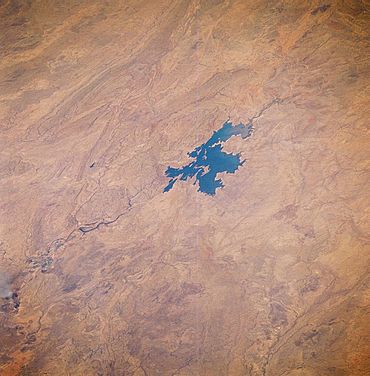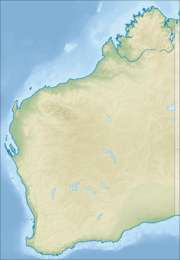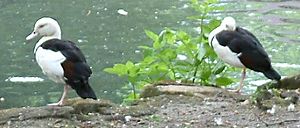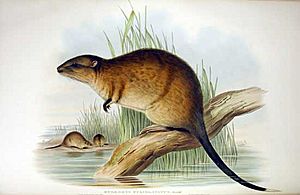Lakes Argyle and Kununurra Ramsar Site facts for kids
Quick facts for kids Lakes Argyle and Kununurra Ramsar SiteWestern Australia |
|
|---|---|

View of Lake Argyle from space, looking south-east, with the Ord River valley and Lake Kununurra at lower left
|
|
| Established | 7 June 1990 |
| Area | 1,500 km2 (579.2 sq mi) |
| Footnotes | |
| Official name: Lakes Argyle and Kununurra | |
| Designated: | 7 June 1990 |
| Reference #: | 478 |
The Lakes Argyle and Kununurra Ramsar Site is a special place in northern Western Australia. It's made up of huge man-made freshwater lakes and wetlands. These were created by building dams on the Ord River in the Kimberley Region. The two main lakes are Lake Argyle and Lake Kununurra. This area is home to many unique plants and lots of different animals. Because it's so important for nature, this 1,500 square kilometer site was named a wetland of international importance under the Ramsar Convention on June 7, 1990. It's known as Ramsar Site 478.
About the Lakes and Dams
The lakes and wetlands here were created as part of the Ord River Irrigation Scheme. This big project aimed to use the Ord River's water for farming.
The first dam, called the diversion dam, was finished in 1963. It flooded the Ord River valley, creating Lake Kununurra and other wetlands like Lily Creek Lagoon.
Then, the Argyle Dam was completed in 1972. This created the much larger Lake Argyle. The town of Kununurra was built near the diversion dam.
People use this area for many things. Farmers use the water for irrigated tropical agriculture. There's also diamond mining and lots of tourism.
Plants and Animals of the Lakes
The water levels in Lake Argyle change a lot each year, by about 3 meters. But in Lake Kununurra, the water levels stay mostly the same. This helps plants grow well along its edges.
You can see dead trees in the lakes. These trees were killed when the areas were flooded after the dams were built. The lakes are very deep, and large parts of them don't have water plants.
Because Lake Argyle's water levels go up and down so much, not many plants grow along its shoreline. However, Lake Kununurra and its wetlands have lots of plants. You'll find bulrushes, grassland, and savanna woodland along the edges.
Some of the trees you might see include broad-leaved paperbark, Eucalyptus microtheca, river red gum, Nauclea orientalis, Sesbania formosa, and Lophostemon grandiflorus.
Amazing Waterbirds
The lakes are a very important safe place for waterbirds, especially during the dry season. More than 20,000 waterbirds are usually here, and sometimes up to 200,000! Lake Argyle is one of the best places in northern Australia to see large groups of waterbirds.
Many different kinds of birds live here. You might see thousands of glossy ibis, magpie goose, wandering whistling duck, and plumed whistling duck. Other common birds include the radjah shelduck, Pacific black duck, grey teal, pink-eared duck, hardhead, green pygmy goose, and Eurasian coot. The comb-crested jacana is also very common here.
Over 200 types of birds, both waterbirds and land birds, have been seen in this area.
Other Animals
Besides birds, the area is home to several kinds of microbats. You can also spot the little red and black flying-foxes. The rakali, which is an Australian water-rat, lives here too. And, of course, there are many freshwater crocodiles in the lakes!





